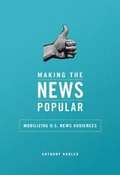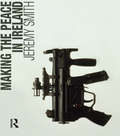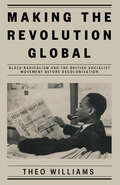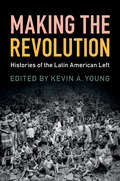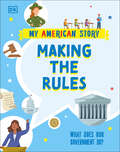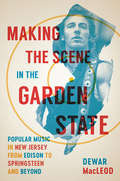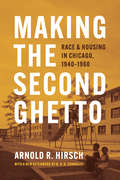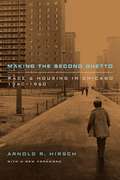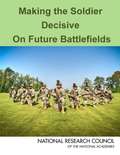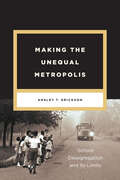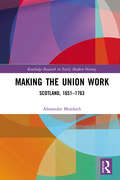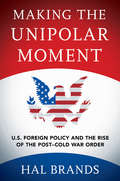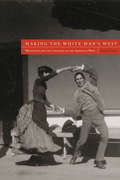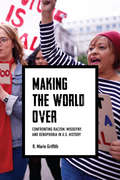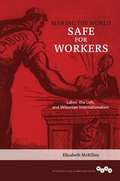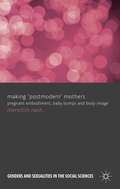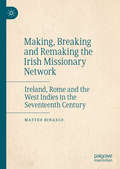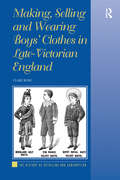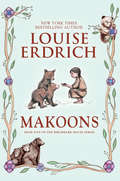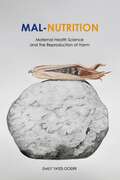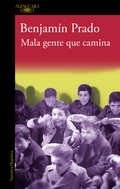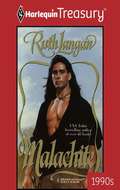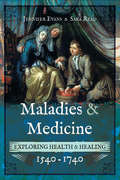- Table View
- List View
Making the News Popular: Mobilizing U.S. News Audiences
by Anthony M NadlerThe professional judgment of gatekeepers defined the American news agenda for decades. Making the News Popular examines how subsequent events brought on a post-professional period that opened the door for imagining that consumer preferences should drive news production--and unleashed both crisis and opportunity on journalistic institutions. Anthony Nadler charts a paradigm shift, from market research's reach into the editorial suite in the 1970s through contemporary experiments in collaborative filtering and social news sites like Reddit and Digg. As Nadler shows, the transition was and is a rocky one. It also goes back much further than many experts suppose. Idealized visions of demand-driven news face obstacles with each iteration. Furthermore, the post-professional philosophy fails to recognize how organizations mobilize interest in news and public life. Nadler argues that this civic function of news organizations has been neglected in debates on the future of journalism. Only with a critical grasp of news outlets' role in stirring broad interest in democratic life, he says, might journalism's digital crisis push us towards building a more robust and democratic news media.
Making the Peace in Ireland
by Jeremy SmithFor nearly thirty years Northern Ireland has been a by-word for terrorism, bloodshed, military coercion and intense communal conflict. However, Ireland is now experiencing a transition from a society in conflict to one at peace. Where did the violence come from and why could it not be pacified? Why has it taken thirty years to solve the Northern Irish conflict, and why did early attempts at settlement fail? Jeremy Smith explores these questions by placing the events in context with wider British and European patterns, giving the first in-depth study of the history of the peace process in Northern Ireland.
Making the Revolution Global: Black Radicalism and the British Socialist Movement before Decolonisation
by Theo WilliamsHow black radicals reshaped the British leftMaking the Revolution Global shows how black radicals transformed socialist politics in Britain in the years before decolonisation. African and Caribbean activist-intellectuals, such as Amy Ashwood Garvey, C.L.R. James, Jomo Kenyatta, Kwame Nkrumah and George Padmore, came to Britain during the 1930s and 1940s and intervened in debates about capitalism, imperialism, fascism and war. They consistently argued that any path towards international socialism must have colonial liberation at its heart. Although their ideas were met with opposition from many on the British Left, they convinced significant sections of the movement of the revolutionary potential of colonised peoples. By centring the entanglements between black radicals and the wider British socialist movement, Theo Williams casts new light on responses to the 1935 Italian invasion of Ethiopia, the 1945 Fifth Pan-African Congress, and a wealth of other events and phenomena. In doing so, he showcases a revolutionary tradition that, as illustrated by the global Black Lives Matter demonstrations of 2020, is still relevant today.
Making the Revolution: Histories of the Latin American Left
by Kevin A. YoungMany treatments of the twentieth-century Latin American left assume a movement populated mainly by affluent urban youth whose naïve dreams of revolution collapsed under the weight of their own elitism, racism, sexism, and sectarian dogmas. However, this book demonstrates that the history of the left was much more diverse. Many leftists struggled against capitalism and empire while also confronting racism, patriarchy, and authoritarianism. The left's ideology and practice were often shaped by leftists from marginalized populations, from Bolivian indigenous communities in the 1920s to the revolutionary women of El Salvador's guerrilla movements in the 1980s. Through ten historical case studies of ten different countries, Making the Revolution highlights some of the most important research on the Latin American left by leading senior and up-and-coming scholars, offering a needed corrective and valuable contribution to modern Latin American history, politics, and sociology.
Making the Rules: What does our Government do? (My American Story)
by DKInspires young learners to explore America&’s government institutions through the nation&’s history and the experience of modern AmericansPart of an inspiring series of books that supports students in understanding government and civics in the United States, Making the Rules interweaves historical context, events, and personalities with the experiences of modern Americans to help students understand key social studies topics, including the origins of American institutions and values and their relevance to young people&’s lives today.The book explores government&’s impact on daily life, including raising money through taxation, security, protecting citizens&’ rights, organization, and providing services. The author also explains the role of other authorities such as state government. Historical topics and events include examples of different roles of government: security during wartime, providing services, and supporting people in need of help.
Making the Scene
by Stuart HendersonMaking the Scene is a history of 1960s Yorkville, Toronto's countercultural mecca. It narrates the hip Village's development from its early coffee house days, when folksingers such as Neil Young and Joni Mitchell flocked to the scene, to its tumultuous, drug-fuelled final months. A flashpoint for hip youth, politicians, parents, and journalists alike, Yorkville was also a battleground over identity, territory, and power. Stuart Henderson explores how this neighbourhood came to be regarded as an alternative space both as a geographic area and as a symbol of hip Toronto in the cultural imagination.Through recently unearthed documents and underground press coverage, Henderson pays special attention to voices that typically aren't heard in the story of Yorkville - including those of women, working class youth, business owners, and municipal authorities. Through a local history, Making the Scene offers new, exciting ways to think about the phenomenon of counterculture and urban manifestations of a hip identity as they have emerged in cities across North America and beyond.
Making the Scene in the Garden State: Popular Music in New Jersey from Edison to Springsteen and Beyond
by Dewar MacLeodMaking the Scene in the Garden State explores New Jersey’s rich musical heritage through stories about the musicians, listeners and fans who came together to create sounds from across the American popular music spectrum. The book includes chapters on the beginnings of musical recording in Thomas Edison’s factories in West Orange; early recording and the invention of the Victrola at Victor Records’ Camden complex; Rudy Van Gelder’s recording studios (for Blue Note, Prestige, and other jazz labels) in Hackensack and Englewood Cliffs; Zacherley and the afterschool dance television show Disc-o-Teen, broadcast from Newark in the 1960s; Bruce Springsteen’s early years on the Jersey Shore at the Upstage Club in Asbury Park; and, the 1980s indie rock scene centered at Maxwell’s in Hoboken. Concluding with a foray into the thriving local music scenes of today, the book examines the sounds, sights and textures of the locales where New Jerseyans have gathered to rock, bop, and boogie.
Making the Second Ghetto: Race & Housing in Chicago, 1940–1960 (Historical Studies of Urban America)
by Arnold R. HirschFirst published in 1983 and praised by the likes of Ta-Nehisi Coates and Thomas Sugrue, Arnold R. Hirsch’s Making the Second Ghetto is the rare book that has only become more piercingly prescient over the years. Hirsch’s classic and groundbreaking work of urban history is a revelatory look at Chicago in the decades after the Great Depression, a period when the city dealt with its rapidly growing Black population not by working to abolish its stark segregation but by expanding and solidifying it. Even as the civil rights movement rose to prominence, Chicago exploited a variety of methods of segregation—including riots, redevelopment, and a host of new legal frameworks—that provided a national playbook for the emergence of a new kind of entrenched inequality. Hirsch’s chronicle of the strategies employed by ethnic, political, and business interests in reaction to the Great Migration of Southern Blacks in the mid-twentieth century makes startingly clear how the violent reactions of an emergent white population found common ground with policy makers to segregate first a city and then the nation. This enlarged edition of Making the Second Ghetto features a visionary afterword by historian N. D. B. Connolly, explaining why Hirsch’s book still crackles with “blistering relevance” for contemporary readers.
Making the Second Ghetto: Race and Housing in Chicago, 1940-1960
by Arnold R. HirschIn Making the Second Ghetto, Arnold Hirsch argues that in the post-depression years Chicago was a "pioneer in developing concepts and devices" for housing segregation. Hirsch shows that the legal framework for the national urban renewal effort was forged in the heat generated by the racial struggles waged on Chicago's South Side. His chronicle of the strategies used by ethnic, political, and business interests in reaction to the great migration of southern blacks in the 1940s describes how the violent reaction of an emergent "white" population combined with public policy to segregate the city. "In this excellent, intricate, and meticulously researched study, Hirsch exposes the social engineering of the post-war ghetto. "—Roma Barnes, Journal of American Studies "According to Arnold Hirsch, Chicago's postwar housing projects were a colossal exercise in moral deception. . . . [An] excellent study of public policy gone astray. "—Ron Grossman, Chicago Tribune "An informative and provocative account of critical aspects of the process in [Chicago]. . . . A good and useful book. "—Zane Miller, Reviews in American History "A valuable and important book. "—Allan Spear, Journal of American History
Making the Soldier Decisive on Future Battlefields
by Division On Engineering Physical SciencesThe U. S. military does not believe its soldiers, sailors, airmen, and marines should be engaged in combat with adversaries on a "level playing field. " Our combat individuals enter engagements to win. To that end, the United States has used its technical prowess and industrial capability to develop decisive weapons that overmatch those of potential enemies. In its current engagement--what has been identified as an "era of persistent conflict"-- the nation's most important weapon is the dismounted soldier operating in small units. Today's soldier must be prepared to contend with both regular and irregular adversaries. Results in Iraq and Afghanistan show that, while the U. S. soldier is a formidable fighter, the contemporary suite of equipment and support does not afford the same high degree of overmatch capability exhibited by large weapons platforms--yet it is the soldier who ultimately will play the decisive role in restoring stability. Making the Soldier Decisive on Future Battlefields establishes the technical requirements for overmatch capability for dismounted soldiers operating individually or in small units. It prescribes technological and organizational capabilities needed to make the dismounted soldier a decisive weapon in a changing, uncertain, and complex future environment and provides the Army with 15 recommendations on how to focus its efforts to enable the soldier and tactical small unit (TSU) to achieve overmatch.
Making the Soviet Intelligentsia: Universities and Intellectual Life under Stalin and Khrushchev
by Benjamin TromlyMaking the Soviet Intelligentsia explores the formation of educated elites in Russian and Ukrainian universities during the early Cold War. In the postwar period, universities emerged as training grounds for the military-industrial complex, showcases of Soviet cultural and economic accomplishments and valued tools in international cultural diplomacy. However, these fêted Soviet institutions also generated conflicts about the place of intellectuals and higher learning under socialism. Disruptive party initiatives in higher education - from the xenophobia and anti-Semitic campaigns of late Stalinism to the rewriting of history and the opening of the USSR to the outside world under Khrushchev - encouraged students and professors to interpret their commitments as intellectuals in the Soviet system in varied and sometimes contradictory ways. In the process, the social construct of intelligentsia took on divisive social, political and national meanings for educated society in the postwar Soviet state.
Making the Unequal Metropolis: School Desegregation and Its Limits (Historical Studies of Urban America)
by Ansley T. EricksonIn a radically unequal United States, schools are often key sites in which injustice grows. Ansley T. Erickson's Making the Unequal Metropolis presents a broad, detailed, and damning argument about the inextricable interrelatedness of school policies and the persistence of metropolitan-scale inequality. While many accounts of education in urban and metropolitan contexts describe schools as the victims of forces beyond their control, Erickson shows the many ways that schools have been intertwined with these forces and have in fact--via land-use decisions, curricula, and other tools--helped sustain inequality. Taking Nashville as her focus, Erickson uncovers the hidden policy choices that have until now been missing from popular and legal narratives of inequality. In her account, inequality emerges not only from individual racism and white communities' resistance to desegregation, but as the result of long-standing linkages between schooling, property markets, labor markets, and the pursuit of economic growth. By making visible the full scope of the forces invested in and reinforcing inequality, Erickson reveals the complex history of, and broad culpability for, ongoing struggles in our schools.
Making the Union Work: Scotland, 1651–1763
by Alexander MurdochMaking the Union Work: Scotland, 1651–1763, explores and analyses existing narratives of Jacobitism and Unionism in late seventeenth to mid-eighteenth century Scotland. Using in-depth archival research, the book questions the extent to which the currency of kinship patronage politics persisted in Scotland as the competing ideologies of Scottish Jacobitism and British Whiggism grew. It discusses the connection between the manifest corruption of patronage politics and the efflorescence of the Scottish Enlightenment. It also examines the stance taken by David Hume and Adam Smith in defining themselves as philosophers first, Whigs second, but Scots above all else, and analyses whether they achieved international success because of or despite the parliamentary union with England in 1707. Organised chronologically and concluding with an assessment of the newly formed United Kingdom in the decades following the 1707 union, Making the Union Work: Scotland, 1651–1763 will be of great interest to researchers and academics of early modern Scotland.
Making the Unipolar Moment: U.S. Foreign Policy and the Rise of the Post-Cold War Order
by Hal BrandsIn the late 1970s, the United States often seemed to be a superpower in decline. Battered by crises and setbacks around the globe, its post–World War II international leadership appeared to be draining steadily away. Yet just over a decade later, by the early 1990s, America's global primacy had been reasserted in dramatic fashion. The Cold War had ended with Washington and its allies triumphant; democracy and free markets were spreading like never before. The United States was now enjoying its "unipolar moment"—an era in which Washington faced no near-term rivals for global power and influence, and one in which the defining feature of international politics was American dominance. How did this remarkable turnaround occur, and what role did U.S. foreign policy play in causing it? In this important book, Hal Brands uses recently declassified archival materials to tell the story of American resurgence.Brands weaves together the key threads of global change and U.S. policy from the late 1970s through the early 1990s, examining the Cold War struggle with Moscow, the rise of a more integrated and globalized world economy, the rapid advance of human rights and democracy, and the emergence of new global challenges like Islamic extremism and international terrorism. Brands reveals how deep structural changes in the international system interacted with strategies pursued by Jimmy Carter, Ronald Reagan, and George H. W. Bush to usher in an era of reinvigorated and in many ways unprecedented American primacy. Making the Unipolar Moment provides an indispensable account of how the post–Cold War order that we still inhabit came to be.
Making the White Man's West: Whiteness and the Creation of the American West
by Jason E. PierceThe West, especially the Intermountain states, ranks among the whitest places in America, but this fact obscures the more complicated history of racial diversity in the region. In Making the White Man’s West, author Jason E. Pierce argues that since the time of the Louisiana Purchase, the American West has been a racially contested space. Using a nuanced theory of historical “whiteness,” he examines why and how Anglo-Americans dominated the region for a 120-year period. In the early nineteenth century, critics like Zebulon Pike and Washington Irving viewed the West as a “dumping ground” for free blacks and Native Americans, a place where they could be segregated from the white communities east of the Mississippi River. But as immigrant populations and industrialization took hold in the East, white Americans began to view the West as a “refuge for real whites.” The West had the most diverse population in the nation with substantial numbers of American Indians, Hispanics, and Asians, but Anglo-Americans could control these mostly disenfranchised peoples and enjoy the privileges of power while celebrating their presence as providing a unique regional character. From this came the belief in a White Man’s West, a place ideally suited for “real” Americans in the face of changing world. The first comprehensive study to examine the construction of white racial identity in the West, Making the White Man’s West shows how these two visions of the West—as a racially diverse holding cell and a white refuge—shaped the history of the region and influenced a variety of contemporary social issues in the West today.
Making the World Over: Confronting Racism, Misogyny, and Xenophobia in U.S. History (Richard E. Myers Lectures)
by R. Marie GriffithThis is more than a study of the issues; it is an attempt to shed real light on how to encourage constructive dialogue and move society forward.
Making the World Safe for Workers: Labor, the Left, and Wilsonian Internationalism (The Working Class in American History)
by Elizabeth McKillenIn this intellectually ambitious study, Elizabeth McKillen explores the significance of Wilsonian internationalism for workers and the influence of American labor in both shaping and undermining the foreign policies and war mobilization efforts of Woodrow Wilson's administration. McKillen highlights the major fault lines and conflicts that emerged within labor circles as Wilson pursued his agenda in the context of Mexican and European revolutions, World War I, and the Versailles Peace Conference. As McKillen shows, the choice to collaborate with or resist U.S. foreign policy remained an important one for labor throughout the twentieth century. In fact, it continues to resonate today in debates over the global economy, wars in Iraq and Afghanistan, and the impact of U.S. policies on workers at home and abroad.
Making ‘Postmodern’ Mothers
by Meredith NashBased on interviews with pregnant women, this book provides a multi-disciplinary empirical account of pregnant embodiment and how it relates to wider sociological and feminist discourses about gender, bodies, 'fitness', 'fat', celebrity and motherhood.
Making, Breaking and Remaking the Irish Missionary Network: Ireland, Rome and the West Indies in the Seventeenth Century
by Matteo BinascoThis book reconstructs the efforts that were made to establish a missionary network between the two Irish Colleges of Rome, Ireland, and the West Indies during the seventeenth century. It analyses the process which brought the Irish clergy to establish two dedicated colleges in the epicenter of early modern Catholicism and to develop a series of missionary initiatives in the English islands of the West Indies. During a period of great political change in Ireland, continental Europe and the Atlantic region, the book traces how and through which key figures and institutions this clerical channel was established, while at the same time identifying the main obstacles to its development.
Making, Selling and Wearing Boys' Clothes in Late-Victorian England (The History of Retailing and Consumption)
by Clare RoseThere has been a great deal of recent interest in masculine clothing, examining both its production and consumption, and the ways in which it was used to create individual identities and to build businesses, from 1850 onwards. Drawing upon a wide range of sources this book studies the interaction between producers and consumers at a key period in the development of the ready-made clothing industry. It also shows that many innovations in advertising clothing, usually considered to have been developed in America, had earlier British precedents. To counter the lack of documentary evidence that has hitherto hampered research into the dress practices of non-elite groups, this book utilises thousands of unpublished visual documents. These include hundreds of manufacturers' designs, which underline an unexpected degree of investment by manufacturers in boys' clothing, and which was matched by heavy investment in advertising, with thousands of images of boys' clothing for shop catalogues in the Stationers' Hall copyright archive. Another key source is the archives of Dr Barnardo's Homes. This extraordinary collection contains over 15,000 documented photographs of boys entering between 1875 and 1900, allowing us to look beyond official polarization of 'raggedness' and 'respectability' used by charities and social reformers of all stripes and to establish the clothing that was actually worn by a large sample of boys. A close analysis of 1,800 images reveals that even when families were impoverished, they strove to present their boys in ways that reflected their position in the family group and in society. By drawing on these visual sources, and linking the design and retailing of boys' clothing with social, cultural and economic issues, this book shows that an understanding of the production and consumption of the boys clothing is central to debates on the growth of the consumer society, the development of mass-market fashion, and concepts of childhood and masculinity.
Makoons (Birchbark House #5)
by Louise ErdrichIn the sequel to Chickadee, acclaimed author Louise Erdrich continues her award-winning Birchbark House series with the story of an Ojibwe family in nineteenth-century America.Named for the Ojibwe word for little bear, Makoons and his twin, Chickadee, have traveled with their family to the Great Plains of Dakota Territory. There they must learn to become buffalo hunters and once again help their people make a home in a new land. But Makoons has had a vision that foretells great challenges--challenges that his family may not be able to overcome.Based on Louise Erdrich's own family history, this fifth book in the series features black-and-white interior illustrations, a note from the author about her research, as well as a map and glossary of Ojibwe terms.
Mal-Nutrition: Maternal Health Science and the Reproduction of Harm
by Emily Yates-DoerrA free ebook version of this title is available through Luminos, University of California Press’s Open Access publishing program. Visit www.luminosoa.org to learn more.Mal-Nutrition documents how maternal health interventions in Guatemala are complicit in reproducing poverty. Policy makers speak about how a critical window of biological growth around the time of pregnancy—called the "first 1,000 days of life"—determines health and wealth across the life course. They argue that fetal development is the key to global development. In this thought-provoking and timely book, Emily Yates-Doerr shows that the control of mothering is a paradigmatic technique of American violence that serves to control the reproduction of privilege and power. She illustrates the efforts of Guatemalan scientists, midwives, and mothers to counter the harms of such mal-nutrition. Their powerful stories offer a window into a form of nutrition science and policy that encourages collective nourishment and fosters reproductive cycles in which women, children, and their entire communities can flourish.
Mala gente que camina (Los casos de Juan Urbano #Volumen 1)
by Benjamín PradoUna conmovedora historia sobre la España de los cuarenta, los años más feroces del hambre y la represión. Un profesor de instituto investiga, casi por azar, la historia de una enigmática escritora que pese a ser militante de la Sección Femenina y la organización de beneficencia infantil Auxilio Social, publicó una única novela en la que parece denunciar, entre líneas, uno de los mayores dramas de la posguerra: el robo de niños a las presas republicanas para serles entregados a familias afines al Régimen. Pero su vida resulta ser muy distinta de lo que parecía. La realidad es una gran ficción representada en medio de un mundo a su vez cínico, en el que algunos de los escritores falangistas más célebres del momento tampoco eran en absoluto los tempranos opositores a la dictadura que cuenta su leyenda sino unos oscuros manipuladores de la verdad y de sus propias biografías. Mala gente que camina, como escribióAntonio Machado. Una novela que intenta «bucear en las aguas negras del franquismo y desactivar las verdades minadas con que sus protagonistas habían sembrado el territorio conquistado». Una conmovedora historia sobre la España de los cuarenta, los años más feroces del hambre y la represión.
Malachite
by Ruth LanganFrom the wilds of Montana emerges one last Jewel, an unknown brother burning with hatred for his father's might legacy. Malachite-as wild and untamed as the devil stallion he has vowed to vanquish. But he cannot conquer the way his Comanche blood rages for gentle mother and widow Millie Potter. For in her devoted gaze and loving arms he knows his lonely heart has finally found a home.The Jewels of TexasThe Infamous Jewels of Texas-Diamond, Pearl, Jade And Ruby-Must Face One Final Secret....
Maladies & Medicine: Exploring Health & Healing, 1540–1740
by Jennifer Evans Sara ReadA lively account of medical practices in early modern England: &“Superb . . . an essential piece of social history.&” —Books Monthly It was an era when tooth cavities were thought to be caused by tiny worms and smallpox by an inflammation of the blood, and cures ranged from herbal potions, cooling cordials, blistering the skin, and of course letting blood. Maladies and Medicine tells the story of how the body was understood before the major advances of modern medicine, covering the theory of the four humors and the ways that male and female bodies were conceptualized. It also explains the hierarchy of healers, from university-trained physicians to the women who traveled the country offering cures based on inherited knowledge of homemade remedies, as well as the print explosion of medical health guides, which began to appear in the sixteenth century, from more academic medical textbooks to cheap almanacs. In twenty chapters discussing attitudes toward, and explanations of, some of the most common diseases and medical conditions of the period, the book reveals the ways people understood them and the steps they took to get better. It examines the body from head to toe, from migraines to gout. Case studies and personal anecdotes taken from doctors&’ notes, personal journals, diaries, letters, and even court records show the reactions of individuals to their illnesses and treatments, bringing us into close proximity with people who lived roughly four centuries ago. This richly illustrated study will fascinate those curious about the history of the body and the way our ancestors lived.
